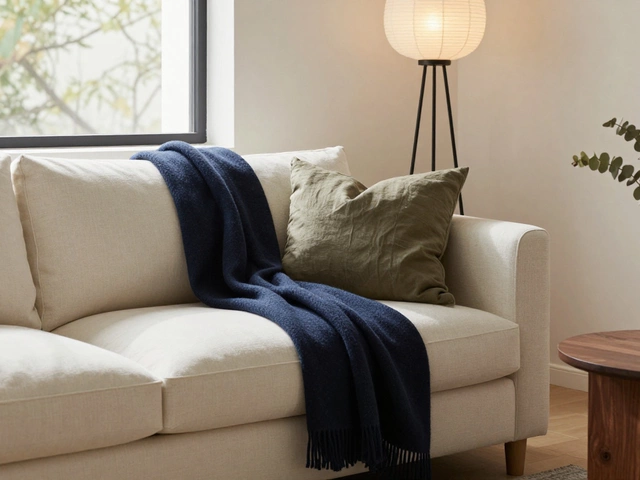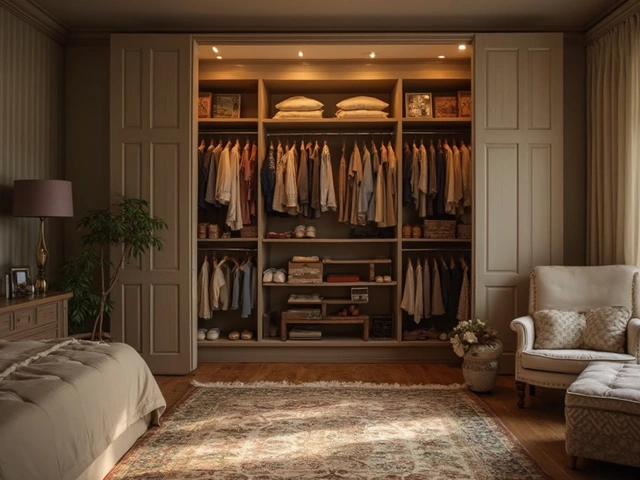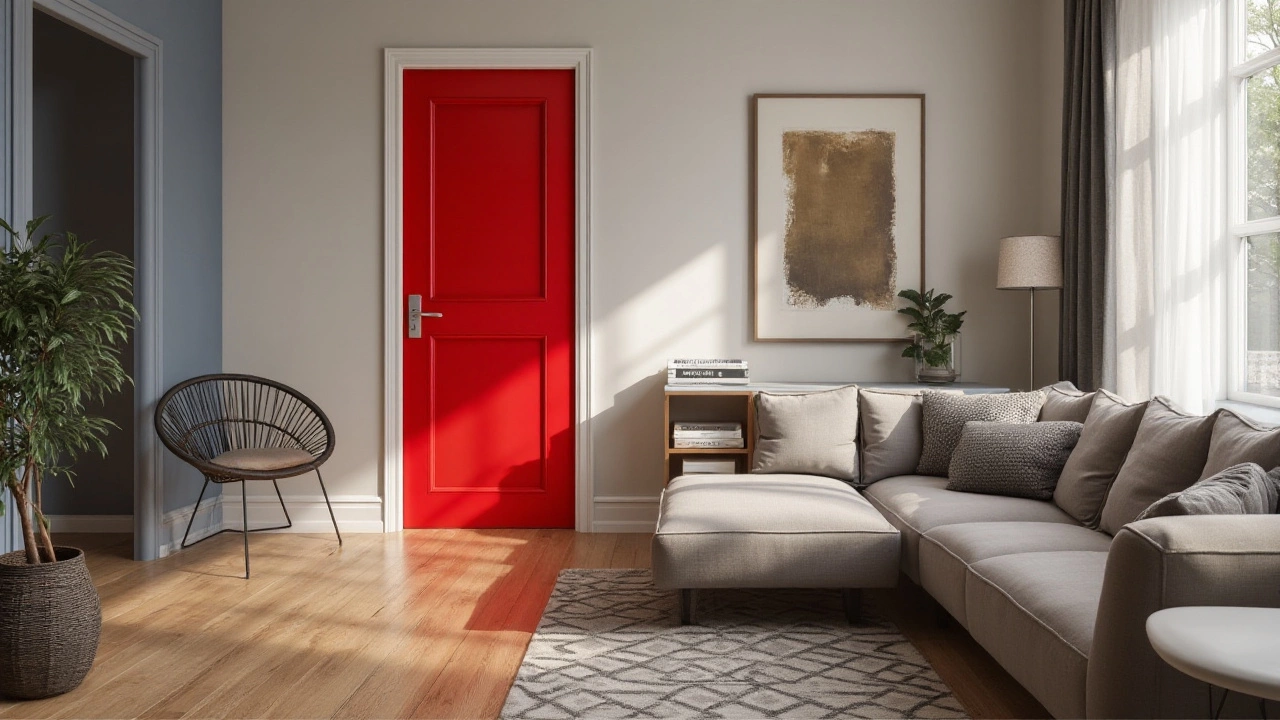
In the world of home interiors, the humble door often plays a surprising role in shaping the aesthetic and feel of a room. As we look ahead into 2024, a vibrant palette of interior door colors is making its mark on modern home design, offering homeowners a wonderful opportunity to refresh or redefine their spaces with just a stroke of color.
Gone are the days when doors were simply neutral. Now, they're coming alive with bold, expressive colors that generate energy and mood. The right choice can act not just as a barrier but as a statement piece, tying together the elements of a room in unexpected ways. Yet, while variety abounds, not every color suits every space, and the task of picking the perfect hue demands both creative passion and a bit of strategic thinking.
- The Power of Bold Colors
- Embracing Earthy Tones
- Timeless Neutrals and Whites
- Color Psychology in Interior Design
- Practical Tips for Choosing Door Colors
The Power of Bold Colors
In recent years, the trend towards embracing bold colors in home design has gained significant momentum, and interior doors are no exception. These vibrant hues are no longer merely reserved for accent walls or artwork but have found their way onto doors, transforming them into unexpected focal points. The allure of bold colors lies in their ability to add personality and flair to spaces that might otherwise feel monotonous. By opting for daring shades, homeowners can make a dramatic statement, reflecting their unique style and character.
From rich, royal blues to fiery reds and deep emeralds, these daring choices can revitalize a room's atmosphere. A striking door color not only breaks visual monotony but also creates a welcoming energy that permeates the entire space. Designers assert that one of the simplest ways to create a memorable impression is through these colorful expressions. By using modern interiors as a canvas, bold doors can either complement or contrast the existing décor, depending on the desired effect. It’s about creating harmony or a delightful clash, a play between the established and the modern.
Color psychology plays a significant role in why some homeowners gravitate towards brighter tones. For instance, red doors are said to symbolize passion and energy, while a sunny yellow can evoke warmth and friendliness. These emotional triggers provide an added layer of meaning to the choice of color, engaging not just the eye but also the mood. Homeowners who are open to experimenting with bold colors on doors often find that it rejuvenates their space in unexpected ways, crafting rooms that are both invigorating and comforting.
"The psychological impact of color should not be underestimated," mentions Erika Woelfel, a renowned color expert.
She argues that the right color can change how people feel in a space, influencing emotions and behaviors in a subtle yet powerful manner.As such, selecting an impactful color needs careful deliberation, ensuring that it aligns with the atmospheric and emotional tone one desires for their home.
Choosing a bold color for interior doors also carries practical advantages. For instance, it can serve as an effective wayfinding tool within larger homes, distinguishing various rooms by their unique color-coded doors. This approach is not only functional but adds an element of fun and surprise for guests who enter. A thoughtfully chosen color scheme can weave a narrative throughout the house, turning each door into a chapter of the dwelling's story.
Highlighting current trends, it's evident that bold interior door colors are not just passing fads but rather a part of a broader movement towards self-expression and personalization in home design. Whether it’s a single statement door or a collection of vividly colored entries, the impact of bold colors in home decor trends is profound, setting the stage for a vibrant and inspiring living environment.
Embracing Earthy Tones
Earthy tones are casting a warm, welcoming glow across modern interiors, setting a trend that aligns beautifully with the comeback of nature-inspired design practices. This color palette, comprising shades like terracotta, moss green, taupe, and deep clay, offers an alluring versatility that has gained the attention of homeowners looking to create a serene and grounded atmosphere in their living spaces. One of the remarkable attributes of earthy tones is their uncanny ability to blend seamlessly with a multitude of design styles, whether you're enamored by the minimalism of Scandinavian interiors or the rustic charm of Country Chic.
The psychological appeal of these natural hues lies in their inherent connection to the environment, evoking feelings of stability and tranquility. When applied to interior doors, these tones don’t just demarcate thresholds; they act as conduits of calm and relaxation. This aspect is particularly valuable in today’s fast-paced world where homes serve as sanctuaries from the outside chaos. As Dulux color specialist Andrea Lucena-Orr once noted, 'Harnessing the calming effect of earthy tones can transform rooms into cocoons of comfort.' This insight rings true across various settings within a home.
Moreover, there’s an environmental consciousness factor at play. Earthy tones often mirror sustainable living themes, aligning with a growing public interest in eco-friendly practices. Selecting paint options that are both vibrant and environmentally considerate allows homeowners to make decor choices that reflect personal values. For those wondering how to integrate earthy tones, it's worth considering them as an anchor point around which other design elements revolve. A clay-colored door can complement a rich wood floor or play off muted furnishings, highlighting subtle textures and contrasts.
Practical Application and Styling Tips
Incorporating these hues into a modern interior design extends beyond just injecting color into your space. It's about creating a unified experience where each room subtly echoes the tranquility of the outdoors. When planning your interior design, consider pairing an earth-toned door with metal or glass hardware for an elegant touch that maintains a contemporary feel. Alternatively, match these colors with accent plants or landscape artwork to foster a seamless indoor-outdoor connection.For an even richer ambiance, layering different shades within the earthy spectrum can add depth and interest. A door in muted ochre might pair with wall treatments in lighter sand or soft olive, creating a harmonious gradient effect. It's these little touches that can transform a home's ambiance into something both tranquil and visually captivating, encouraging a mindful approach to modern living.
- Choose non-toxic, low-VOC paints that are both safe and environmentally responsible.
- Consider the lighting in your space as it can dramatically alter the perception of earthy tones.
- Use these shades to emphasize architectural features, turning doors into central design elements.
- Explore textured finishes to add a tactile dimension.
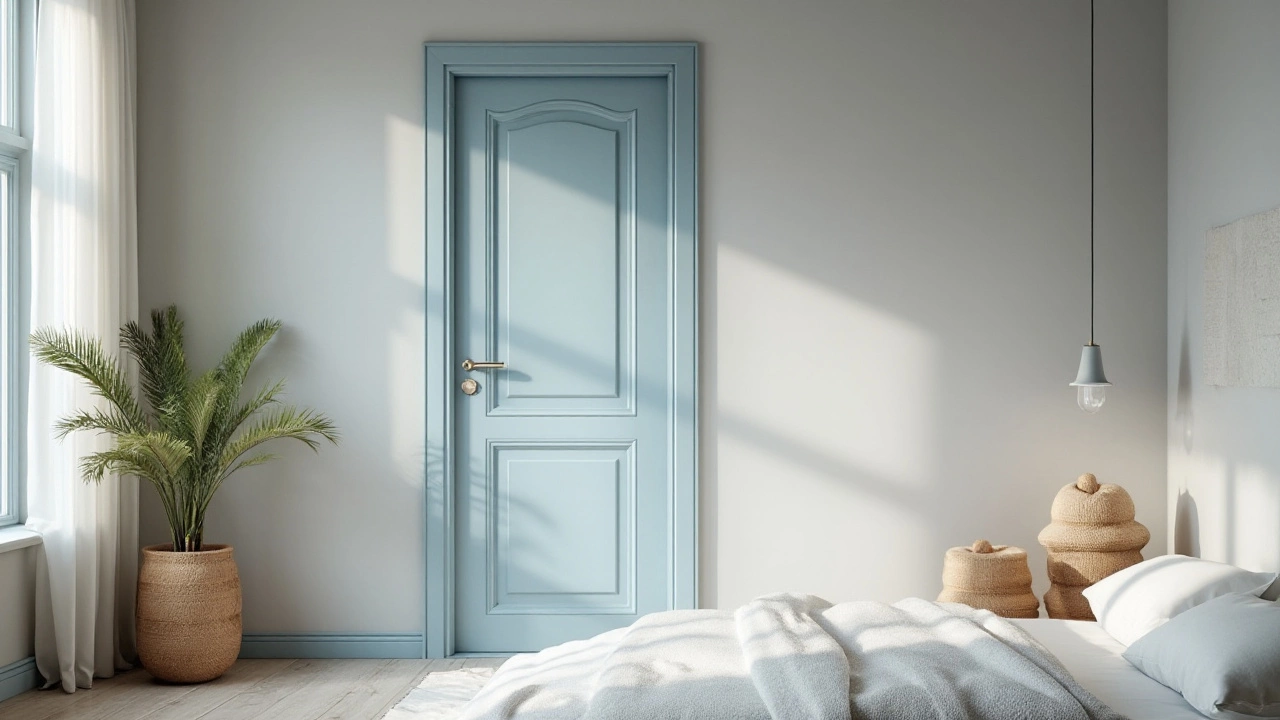
Timeless Neutrals and Whites
Timelessness in design is never out of style, and when it comes to interior door colors, nothing exudes such enduring charm as neutrals and whites. They may appear understated, but these shades hold a powerful presence, effortlessly complementing diverse decor themes from minimalistic to eclectic. Neutrals, including shades of taupe, greige, and soft ivory, serve as a versatile canvas that lets furniture and artwork shine, adapting gracefully to seasonal changes. Whites offer a fresh, clean look that brightens spaces and makes them feel open and airy. Such colors are known for their ability to create a calming, serene environment, a quality that's much appreciated in our fast-paced world.
These colors are not just about tones but also about reflection and illumination. In spaces that lack natural light, a white door can reflect existing light around the room, making it seem brighter and more welcoming. Their simplicity doesn't intrude on the architectural beauty or existing color palette but enhances it. This is particularly beneficial in homes with bold accent walls or intricate floor patterns, where the door shouldn’t compete but rather harmonize. Many professional designers swear by these hues for their adaptability and elegance. A renowned designer once stated, "A neutral palette is never just the absence of color, but the presence of sophistication."
"A door painted in neutral or white becomes a silent partner in space, allowing other elements to speak their own language." — Victoria Hagan, Interior Designer
The practical benefits of choosing neutrals and whites extend beyond aesthetics; they also contribute to property value. Doors in these colors appeal widely to potential buyers because they symbolize a fresh start and are less likely to clash with the new owner's vision. Maintenance is another factor where these colors hold an edge. With advancements in paint and finishing technologies, modern formulations resist the yellowing that sometimes beset white paints in the past, maintaining their purity over time. As a tip for maintaining their beauty, consider a semi-gloss finish, which highlights the door's details while being easier to clean. For those concerned about marks or handprints, using a washable paint can keep things looking pristine.
When considering home decor trends and choosing your interior door color, neutrals and whites offer a blank slate that caters to dynamic lifestyle changes. These shades stand as a testament to the beauty found in simplicity, encapsulating a quiet dignity that endures where others wane. Whether you're renovating with resale in mind or just looking to refresh your living space with a timeless touch, repainting doors in these classic shades is a sound choice. As the modern home increasingly values flexibility and understated elegance, the appeal of neutral door colors remains untouched, assuring their place in design narratives for years to come.
Color Psychology in Interior Design
Color psychology is an often underestimated but highly influential aspect of interior design, with each hue capable of evoking specific emotions and moods within a living space. As homes become sanctuaries where people seek solace and inspiration, understanding the nuances of color psychology becomes paramount. Choosing the right interior door colors can set the tone for an entire room. For instance, blue shades are known for their calming effect, making them a popular choice for bedrooms or spaces meant for relaxation. On the other hand, warm colors like red and yellow can introduce energy and cheer, ideal for areas where there's a lot of movement and activity.
It's fascinating to consider how different cultures perceive colors differently. While white often symbolizes purity in Western cultures, it's traditionally worn at funerals in some Eastern societies, representing mourning. Such cultural nuances can influence homeowners' choices when designing their homes with trend-conscious door colors. A deep emerald green door, for instance, might suggest prosperity and growth due to its association with nature and tranquility. However, selecting a specific color, balancing its vibrancy or subtlety, requires more than cultural insights; it calls for a personal reflection on how a color affects one's mood and energy.
Some experts argue that colors can impact our physiological responses. A room painted in bold, intense colors like bright red or fiery orange may elevate heart rates and stimulate appetites, thus commonly found in spaces like dining rooms or kitchens. An interesting blend of such colors might create an inviting yet intense atmosphere, sparking conversation and interaction. Conversely, muted or pastel colors, often employed in spaces intended for introspection such as home offices or reading nooks, can create a serene and thoughtful environment. I recall reading an impactful statement in 'Color Psychology Today':
'Colors are not just visual stimuli; they are powerful emotional triggers that shape the way we perceive our world.'This conception strengthens the idea that paying close attention to home decor trends isn't merely about aesthetic alignment but also about curating emotional experiences within our personal spaces.
Designers also oftentimes harness the potential of color psychology by creating color flow between rooms, ensuring a seamless emotional transition. This uninterrupted flow can be tailored to your home's natural lighting, accentuating the prevailing ambiance throughout the day. For practical purposes and to embrace emerging 2024 design trends, one might experiment with an accent door in a vibrant hue while keeping surrounding elements neutral, allowing the door to become a strong centerpiece without overwhelming the senses.
To summarize, the art and science of choosing the right door color blend both intuition and cognition. By understanding the inherent emotional impact of different colors and combining this knowledge with personal taste and cultural influences, homeowners can create spaces that are not only cohesive but emotionally resonant, changing the way they experience their home's interior.
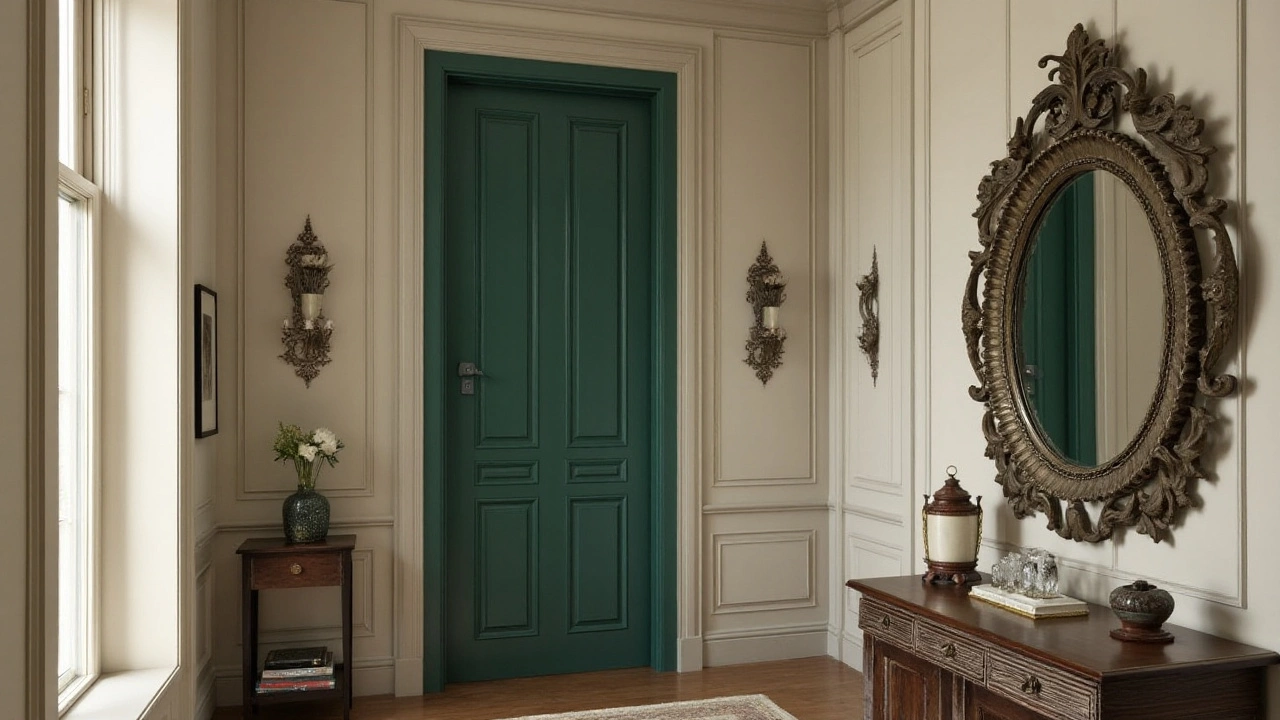
Practical Tips for Choosing Door Colors
Choosing the right interior door colors can significantly elevate the look of your living space. The right shade sets the tone and mood, making this a decision worthy of careful consideration. Before diving into the paint chips and samples, take a moment to evaluate the existing elements in your home. Consider the color palette of the walls, floor, and furnishings, and think about how the door fits into the overall theme. This helps you identify whether you want your door to blend in harmoniously or stand out as a bold, eye-catching feature.
One effective way to select a strong interior door color is by looking at your home’s architectural style. A Craftsman-style home might benefit from rich wood tones or deep greens, while a modern loft could embrace cool blues or bright whites. On the other hand, Scandinavian-inspired spaces usually lean towards simple whites or soft neutral hues that maintain the light and airy feel. When in doubt, classic black is a dependable choice that often adds a touch of elegance and offers striking contrast with lighter walls.
While doors are functional, they can also be an artistic expression. Don't hesitate to weigh the psychological impact of colors, as different hues evoke various emotions. Blue, for instance, can create a calming environment, making it ideal for bedrooms or bathrooms. Yellow, with its positive and energetic vibe, works well for kitchens or playrooms. If you’re choosing a vibrant hue, consider using it on a single door for a statement effect, while keeping others more neutral to avoid visual overload. This can seamlessly incorporate boldness without overwhelming the overall aesthetic.
"Color is a power which directly influences the soul," said artist Wassily Kandinsky. When applying this concept to door color selection, it reminds us of the profound emotional impact our choices can have, whether consciously acknowledged or not.
Lighting can alter how colors appear—what seems dull under incandescent lighting may sparkle in natural sunlight. It’s wise to test a sample on a small area or even view paint samples in different lighting throughout the day before committing. Doing this provides insights into the dynamic nature of colors, helping you avoid expensive regrets. Additionally, note that matte finishes exude a modern and sleek look, while glossy finishes highlight the intricate details of the door’s design patterns.
Functionality meets fashion when considering durability. High-traffic areas like hallways might benefit from more robust paint options or finishes that resist damage and stains. An eggshell or satin finish strikes a balance between durability and appearance, proving practical for spaces where finger marks and scuffs are prominent. If sustainability is a priority, eco-friendly paints with low VOC levels support your green initiatives without compromising style.
In cases where multiple doors are visible simultaneously, it's beneficial to create a cohesive look. You can achieve a balanced color flow by mixing complementary shades or sticking to a two-tone theme throughout connected rooms. For a playful yet sophisticated appearance, consider painting the edge of the door with an accent color that matches or contrasts with other elements in the room. An example is pairing a grey door with a bright coral edge, which provides a delightful surprise when the door is open. Ultimately, the right door color marries function with your personal style, offering a blend of beauty and utility that enriches both your home and your daily experience.

